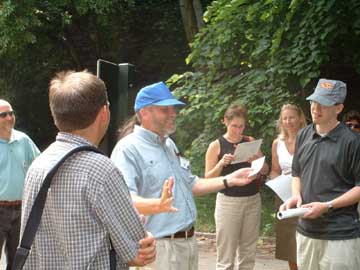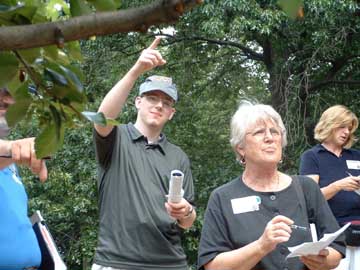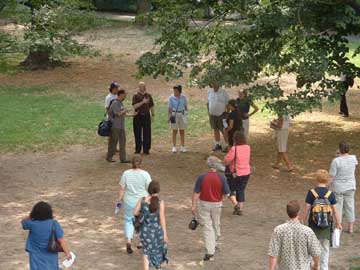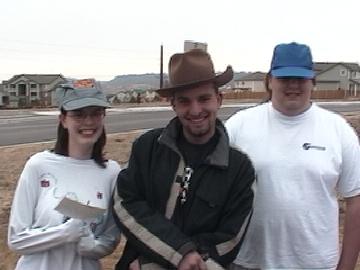
|
Using Triangulation to Locate Meteorites from Witnessed Falls data | hook | main | background & resources | student Andy Caldwell Douglas County High School 2842 Front St. Castle Rock, CO 80104 caldwell@tea.rice.edu Overview Grade Level/Discipline National Standards Earth and Space Science Content Standard D: Energy in the earth system Geochemical Cycles Origin and evolution of the earth system Origin and evolution of the universe Pre-activity set-up It makes it more fun for the students to role play if they have some sort of costume provided, like a hat. The text of the interviews should be written out on notecards for the "witnesses" to act out. For example: Farmer Bob (standing at bear statue): “I was out checking my livestock when a brilliant light appeared over the red light on that skyscraper to the southwest. I knew from taking the museum’s meteorite class that it was just a fragment of a protoplanet or asteroid.”
Pony Tail Penny (at fence): “I was out jogging when I saw this bright flash right over the Qwest building. At first I thought it was another UFO, but then I realized it was probably a stony chondrite.”
Engineer Fred (on sidewalk near lake): “I was driving my train through town the other night when I saw the bright flare right above the museum over yonder. At first I thought it was kids with fireworks, but I guess it was just a meteoroid reaching the point of retardation.”
Take the students to the search area and while the class is drawing their individual maps, instruct each of the "witnesses" about their task. Have students interview each of the "witnesses" and draw lines of sight after each interview. The students should be able to find the "meteorite." Materials
Hats (costumes)
Student:
Paper This activity can be made more accurate with a compass or protractor. Time Frame Engagement and Exploration (Student Inquiry Activity) Explanation (Discussing) They are asked what could make the interviews more accurate and how to improve the search. They could ask for first and last sightings or use a Brunton compass or protractor. They are finally asked how this is like and dislike an authentic meteorite search. They should recognize that a real search involoves often hundreds of witnesses. Each testimonial must be weighed and compared with the rest to determine accuracy. Elaboration (Polar Applications) When a major fireball event occurrs, reports are taken online and evaluated by their location and credibility. A team of volunteers from the Denver Museum of Nature and Science goes out and interviews witnesses who are often hundreds of miles from each other. Any witness' testimony that indicates they were in motion, under the influence of alcohol, or didn't actually see the fireball has to be thrown out. Many witnesses see a flash of light, but don't actually see the fireball. Simply hearing it is also unacceptable. The lines of sight are plotted on a map, and a search area is established for a ground search. Depending on the topography and ownership of the propery, the volunteers will either conduct a foot search for the meteorite(s) or will educate the local residents as to the characteristics of meteorites. The latter procedure is actually more effective. Exchange (Students Draw Conclusions) Evaluation (Assessing Student Performance) data | hook | main | background & resources | student |




